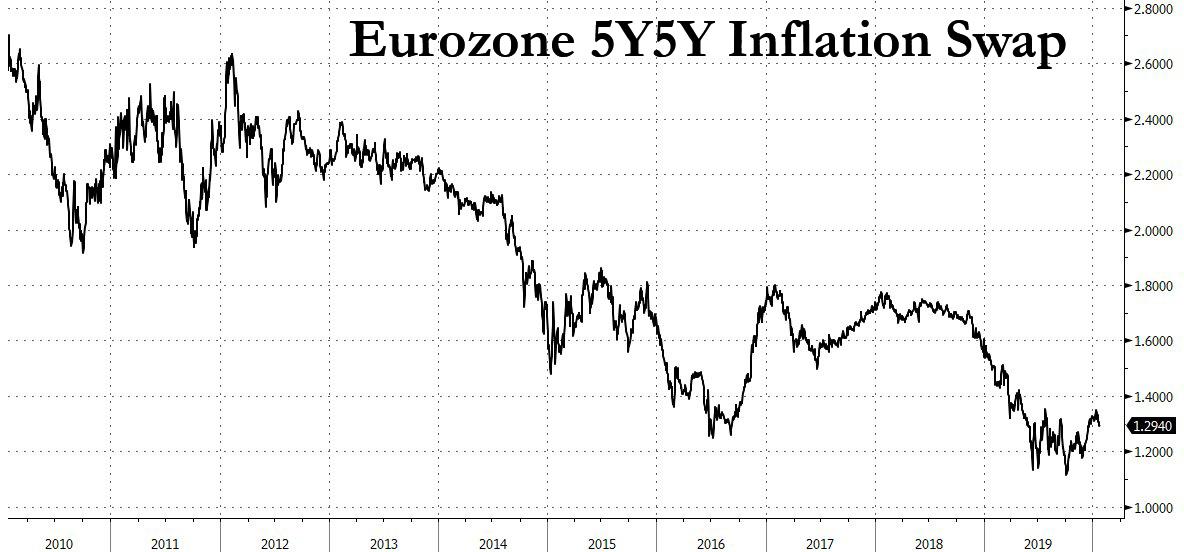Is The Market Underestimating Euro Area Inflation?
Authored by Tony Small, Morgan Stanley strategist
Core and headline inflation data in the euro area finished 2019 above the ECB’s forecasts, as seasonally adjusted measures of underlying inflation climbed to their highest levels since 2013. Many leading indicators suggest that the upside evident in underlying inflation at the end of last year could continue in 2020. Early January commentary from multiple ECB officials suggests that optimism is slowly building within the Governing Council.
Despite the near-term improvement and cautious optimism from some within the ECB, markets remain decidedly sceptical that the move is sustainable. The ECB’s preferred market-based measure, the five-year five-year euro inflation swap, remains stuck near 1.3% (below seasonally adjusted underlying measures for only the second time since the GFC).
And according to Bloomberg, median and average forecaster expectations for end-2020 euro area GDP growth, CPI and 10-year Bund yields stand at or near 18-month lows.
Now we know you’re probably saying to yourself, not another euro area reflation story. We get it, we promise – but give us a few to make our case.
We think there’s a real possibility in 2020 that the markets’ expectations for a rebound in euro area growth and a steady move higher in core inflation measures may prove too pessimistic. This could lead markets to reassess everything – from bank stocks to the outright levels of both inflation breakevens and Bund yields and finally the ECB’s current monetary policy stance.
Over the last couple of years, core inflation has been running well below what existing levels of wage growth and the European Commission future price expectation series for the consumer, services, retail and construction sectors would normally imply. At the same time, a softer manufacturing sector has offset resilient domestic demand and services inflation, but some of that drag may be starting to subside.
In recent months our European and global economics teams have been highlighting the stabilisation and improvement in euro area manufacturing PMIs, upside data surprises across many regions of the globe and an acceleration in European soft data indicators, particularly in Germany, where the latest ZEW expectations survey rose to its highest level since 2015 and the manufacturing and services PMIs surprised strongly to the upside in January.
The better-than-expected data, especially in the euro area, have prompted our European economists to note potential upside risks to their forecast for just a soft rebound in euro area growth in 2020. Importantly, they’re not alone.
The account of the ECB Governing Council’s December 2019 monetary policy meeting had perhaps the most cautiously optimistic tone beneath the surface that we’ve seen in the last couple of years. Members highlighted the reduced uncertainty associated with geopolitical and trade tensions, a significant reduction in euro area recession probabilities, a notable rise in euro area surprise indices and a “solid upward move in underlying inflation” (when excluding volatile package holiday prices in the euro area’s largest economy and measures incorporating the cost of owner-occupied housing, which aren’t included in the Harmonised Index of Consumer Prices). At the recent January 2020 Governing Council meeting, the cautious optimism continued, as the ECB softened its assessment of downside risks to growth from “somewhat less pronounced” to “less pronounced”.
Many of our strategy teams at Morgan Stanley have embraced the idea that markets may be priced for too much pessimism in Europe. Our European equity strategists turned positive on European and UK equities in 4Q19, our European bank strategists initiated a high-conviction overweight on the SX7E banks index towards the end of 2019, and our cross-asset strategy team sees greater value in European equities relative to US equities. Finally, we on the European rates strategy team have been biased towards higher Bund yields since the end of 3Q19.
We realise that many investors will look askance at the idea of European reflation given how often it has failed to materialise. Something to keep in the back of one’s mind, however, is that a new wave of leaders has emerged across the continent, with non-traditional attitudes towards fiscal spending and a strong desire to thoughtfully and thoroughly consider issues including climate change, a banking union and broader euro area fiscal integration.
Policies like the European Commission’s Green New Deal could lead to a wave of investment, lifting Europe’s productivity, potential GDP and nominal growth and inflation. In the meantime, there just may be some signs that euro area reflation is finally on its way.
Tyler Durden
Sun, 01/26/2020 – 16:45
via ZeroHedge News https://ift.tt/2Rv6adi Tyler Durden
